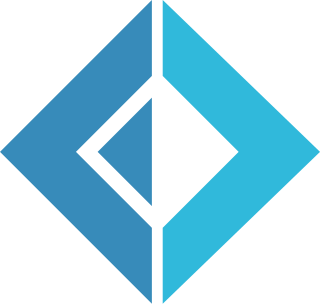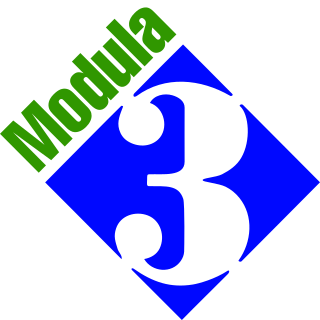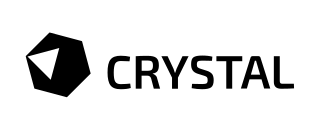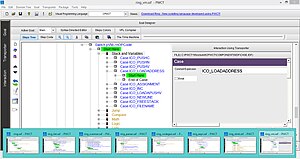Eiffel is an object-oriented programming language designed by Bertrand Meyer and Eiffel Software. Meyer conceived the language in 1985 with the goal of increasing the reliability of commercial software development; the first version becoming available in 1986. In 2005, Eiffel became an ISO-standardized language.

Python is a high-level, general-purpose programming language. Its design philosophy emphasizes code readability with the use of significant indentation.
OCaml is a general-purpose, high-level, multi-paradigm programming language which extends the Caml dialect of ML with object-oriented features. OCaml was created in 1996 by Xavier Leroy, Jérôme Vouillon, Damien Doligez, Didier Rémy, Ascánder Suárez, and others.

Lua is a lightweight, high-level, multi-paradigm programming language designed primarily for embedded use in applications. Lua is cross-platform, since the interpreter of compiled bytecode is written in ANSI C, and Lua has a relatively simple C API to embed it into applications.

Visual Basic (VB), originally called Visual Basic .NET (VB.NET), is a multi-paradigm, object-oriented programming language, implemented on .NET, Mono, and the .NET Framework. Microsoft launched VB.NET in 2002 as the successor to its original Visual Basic language, the last version of which was Visual Basic 6.0. Although the ".NET" portion of the name was dropped in 2005, this article uses "Visual Basic [.NET]" to refer to all Visual Basic languages released since 2002, in order to distinguish between them and the classic Visual Basic. Along with C# and F#, it is one of the three main languages targeting the .NET ecosystem. Microsoft updated its VB language strategy on 6 February 2023, stating that VB is a stable language now and Microsoft will keep maintaining it.

F# is a general-purpose, high-level, strongly typed, multi-paradigm programming language that encompasses functional, imperative, and object-oriented programming methods. It is most often used as a cross-platform Common Language Infrastructure (CLI) language on .NET, but can also generate JavaScript and graphics processing unit (GPU) code.

Modula-3 is a programming language conceived as a successor to an upgraded version of Modula-2 known as Modula-2+. While it has been influential in research circles it has not been adopted widely in industry. It was designed by Luca Cardelli, James Donahue, Lucille Glassman, Mick Jordan, Bill Kalsow and Greg Nelson at the Digital Equipment Corporation (DEC) Systems Research Center (SRC) and the Olivetti Research Center (ORC) in the late 1980s.
ABAP is a high-level programming language created by the German software company SAP SE. It is currently positioned, alongside Java, as the language for programming the SAP NetWeaver Application Server, which is part of the SAP NetWeaver platform for building business applications.
Harbour is a computer programming language, primarily used to create database/business programs. It is a modernised, open source and cross-platform version of the older Clipper system, which in turn developed from the dBase database market of the 1980s and 1990s.

C# is a general-purpose high-level programming language supporting multiple paradigms. C# encompasses static typing, strong typing, lexically scoped, imperative, declarative, functional, generic, object-oriented (class-based), and component-oriented programming disciplines.

The syntax of the Python programming language is the set of rules that defines how a Python program will be written and interpreted. The Python language has many similarities to Perl, C, and Java. However, there are some definite differences between the languages. It supports multiple programming paradigms, including structured, object-oriented programming, and functional programming, and boasts a dynamic type system and automatic memory management.
C# and Visual Basic .NET are the two primary languages used to program on the .NET Framework.
A symbol in computer programming is a primitive data type whose instances have a human-readable form. Symbols can be used as identifiers. In some programming languages, they are called atoms. Uniqueness is enforced by holding them in a symbol table. The most common use of symbols by programmers is to perform language reflection, and the most common indirectly is their use to create object linkages.

Visual FoxPro is a programming language that was developed by Microsoft. It is a data-centric and procedural programming language with object-oriented programming (OOP) features.
Newspeak is a programming language and platform in the tradition of Smalltalk and Self being developed by a team led by Gilad Bracha. The platform includes an integrated development environment (IDE), a graphical user interface (GUI) library, and standard libraries. Starting in 2006, Cadence Design Systems funded its development and employed the main contributors, but ended funding in January 2009.

Go is a statically typed, compiled high-level programming language designed at Google by Robert Griesemer, Rob Pike, and Ken Thompson. It is syntactically similar to C, but also has memory safety, garbage collection, structural typing, and CSP-style concurrency. It is often referred to as Golang because of its former domain name, golang.org, but its proper name is Go.
Objective-C is a high-level general-purpose, object-oriented programming language that adds Smalltalk-style messaging to the C programming language. Originally developed by Brad Cox and Tom Love in the early 1980s, it was selected by NeXT for its NeXTSTEP operating system. Due to Apple macOS’s direct lineage from NeXTSTEP, Objective-C was the standard programming language used, supported, and promoted by Apple for developing macOS and iOS applications until the introduction of the Swift programming language in 2014.

Nim is a general-purpose, multi-paradigm, statically typed, compiled high-level systems programming language, designed and developed by a team around Andreas Rumpf. Nim is designed to be "efficient, expressive, and elegant", supporting metaprogramming, functional, message passing, procedural, and object-oriented programming styles by providing several features such as compile time code generation, algebraic data types, a foreign function interface (FFI) with C, C++, Objective-C, and JavaScript, and supporting compiling to those same languages as intermediate representations.

Crystal is a high-level general-purpose, object-oriented programming language, designed and developed by Ary Borenszweig, Juan Wajnerman, Brian Cardiff and more than 400 contributors. With syntax inspired by the language Ruby, it is a compiled language with static type-checking, but specifying the types of variables or method arguments is generally unneeded. Types are resolved by an advanced global type inference algorithm. Crystal is currently in active development. It is released as free and open-source software under the Apache License version 2.0.

Mahmoud Samir Fayed is a computer programmer, known as the creator of the PWCT programming language. PWCT is a free open source visual programming language for software development. He also created or designed Ring. He is a researcher at King Saud University. Prior to that, he worked at the Riyadh Techno Valley in the Information and Communication Technology Incubator.


























